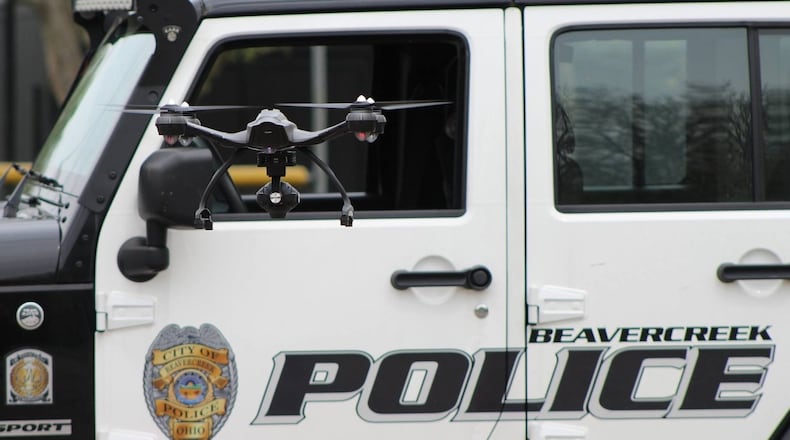RELATED: Beavercreek, Fairborn police to start using drone technology
“There’s a lot of people out there who feel we can take a drone up to spy on them. We can’t and we don’t do that,” Eberle said. “You got to have a warrant unless you have circumstances that would allow it.”
But what if during a missing persons search, the drone flies over a backyard and captures photographic evidence of a crime? Law enforcement could potentially use that footage as probable cause to get a search warrant.
“It’s no different than if you’re in somebody’s house and you notice a marijuana plant. If you think there’s more, you’ve got to go get a warrant … but you stumbled upon it legally,” Eberle said.
MORE: 100 cities line up to fight state on business tax collections
Law enforcement and prosecutors want to be on firm ground when questioned about how evidence is obtained in a case, said Gary Daniels, spokesman and chief lobbyist for the American Civil Liberties Union of Ohio.
“The way current Fourth Amendment privacy case law goes, if you’re out and about outside your home, you almost have no privacy expectations at that point,” Daniels said. “Privacy advocates have been arguing for decades that technology changes how these matters are considered.”
There are no specific laws in Ohio regulating drone-use by law enforcement and some departments using drones are still working on drafting policy. State Sen. Michael Skindell (D-Cleveland) and State Sen. Kris Jordan (R-Delaware) are co-sponsors of Senate Bill 60, a proposed law that spells out how law enforcement should and should not use drones.
Daniels said there have been previous proposals, but so far they have failed to capture lawmakers’ interest.
“We need to have some sort of regulation that is uniform across the state,” Daniels said, “without impacting what law enforcement does when it doesn’t involve privacy concerns.”
MORE: FBI asking for help to ID woman in child porn video
Beavercreek and Fairborn are among the first Dayton area police departments to acquire drones and train officers to fly them. Beavercreek Police Spokesman Capt. Chad Lindsey said they have used a drone in four actual situations this year: Searches for two missing persons and in two criminal investigations.
According to Lindsey, Beavercreek police used a drone in February in an effort to track down a suspect who fled into the woods after stealing an iPhone from the Verizon store at The Greene. In May, Beavercreek police used a drone in an attempt to track down two juveniles who ran from an officer responding to a trespass complaint on Katherine Drive.
The drone-use did not lead to the capture of the suspects, but in both cases they were later identified and located through further investigation, Lindsey said.
The videos captured by the drone during those investigations were deleted.
“Due to the fact they did not provide any evidence or investigative value for the cases, they were not saved,” Lindsey said.
Not retaining video from a police investigation may be concerning from a public records standpoint, but Beavercreek police’s actions are in-line with policy recommendations on drone-use from the American Civil Liberties Union of Ohio.
Daniels said the ACLU has addressed the same issue with the use of police body cameras.
“If it captures data that is of no interest to anyone, the ACLU recommends getting rid of that as soon as possible,” said Daniels, citing privacy concerns.
The Darke County Sheriff’s Office has used a $2,000 drone for about a year and a half, mostly to acquire aerial photos of serious crash scenes, according to Detective Sgt. Chris Clark.
“We have wide open, flat roads. Traffic crashes here can be pretty dramatic,” Clark said. “[The drone] helps for us to get aerial views. It used to be we would call the fire department … This is a more efficient and better way to do it.”
Darke County is rural, with small towns surrounded by expansive farms and fields cultivated to grow corn and soy beans. Clark said drones can help search those rural areas for missing persons and potentially suspects who run away from officers. The drone was used last year to locate the scene of a deadly small airplane that crashed in a field off Dull Road near Arcanum.
The Butler County Sheriff’s Office has added drones to their fleet of police vehicles, which includes two helicopters.
Chief Deputy Anthony Dwyer
“It’s pretty convenient because it’s not the full bird you’re putting up in the air,” Dwyer said. “It’s been helpful. If we have a bad fatal crash for instance, we can get aerial observations quickly … It gives you a visual of the totality of the circumstances.”
About the Author
